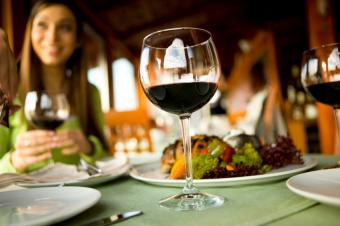
Holding your own wine tasting is a great way to explore new wines and gather with friends or people who have similar interests. And while holding a wine tasting isn't complicated, these tips can help you to create an event that will be entertaining for you and your guests.
1. Narrow Down Your Wine Choices
The world of wine is vast and complex, which can make choosing the wines for your wine tasting seem difficult. One of the easiest ways to narrow down your choices is to choose a theme for your tasting, whether it is based on varietal, price range, or wine region. Some suggestions for a theme:
- Cabernets (or some other varietal) from around the world
- Fabulous budget wines
- Wines from Wine Spectator's Top 100 list
- Sparkling wines and Champagnes
- Wines from a particular vintage
- Bordeaux and Bordeaux-style wines
- Old World varietal versus New World varietal (such as Burgundy versus an Oregon Pinot Noir or a Syrah blend from the Rhone versus a Shiraz blend from Australia)
- Wines for a specific winemaker
- Local wines
2. Hold a Blind Tasting
Something fun to try is to hold a blind wine tasting. This can help remove preconceived notions about the wines based on winemaker, vintage, varietal, or price. In a blind tasting, you and your guests will taste two (or more) wines side-by-side to evaluate their differences and similarities. To do this, you will need wines of similar color and bottle shape. Conceal the identity of each by removing the cork and putting each bottle in a bag or wrapping it in foil (or cover the label) and assign a number to each. Then, have guests taste each wine and record their notes on a blind tasting sheet.

Some ideas for a blind tasting:
- Evaluate the same varietal of inexpensive wine versus an expensive wine
- Evaluate several bottles with similar ratings from Wine Advocate, Wine Spectator, or some other wine rater
- Have tasters guess the varietal for each bottle of wine (for example, have them taste a Grenache, a Syrah, a Cabernet Sauvignon, and a Nebbiolo and see if they can tell what the varietal is)
- Have tasters guess or evaluate different vintages of the same wine
3. Have Everyone Bring a Bottle
One way to defray the cost of holding your own wine tasting is to ask each guest to bring a bottle. Let guests know the theme ahead of time so they can bring an appropriate bottle. You may also specify a budget if you wish so one guest doesn't bring a $500 bottle and another bring a $5 bottle.
4. Choose the Appropriate Glass
If you are tasting white wines, sparkling wines, or blush wines, then you will need glasses with stems so the heat of the tasters' hands won't inadvertently warm up the wines. If you're serving reds, you can use glasses with stems or without. And while there are no requirements for stemware for a wine tasting, you do need to choose clear crystal without etching so the tasters can evaluate the wine's visual characteristics.
5. Provide Palate Cleansers
During a wine tasting, the palate can become easily fatigued. To help refresh the palate, it's essential to offer neutrally flavored palate cleansers such as bread or crackers. Place them in small dishes near where you'll be tasting so guests can help themselves as needed. You should also provide pitchers of water - both for palate cleansing and for a quick rinse of glasses between wines.

6. Serve Wines in the Right Order
The typical way to serve wines in a tasting is from the lightest to the heaviest with any dessert, fortified, or sweet wines at the end of the tasting. Use the following order:
- Sparkling wines
- Light whites (unoaked white wines and varietals such as Pinot Grigio)
- Heavier whites (oaked wines and varietals such as Chardonnay)
- Rosé
- Light reds (such as Pinot Noir or Rioja wines)
- Heavier reds (such as Cabernet Sauvignon or Zinfandel)
- Dessert and sweet wines (such as Port or ice wine)
7. Set Up the Tasting Table
Since the goal of your gathering is wine tasting, you'll want to set up the wine tasting table appropriately. To do this, consider the following:
- Use a white tablecloth to provide a neutral background so tasters can evaluate the wine's visual characteristics
- Provide attractive spit buckets
- Consider placing simple foods on the tables that will pair well with the wines you taste, such as dark chocolate, olives, cheeses, and cornichons.
- If tasters will be using the same glass throughout the night, provide wine glass charms to help them identify their glass.
8. Keep Pours Small
This is especially important if your guests will taste multiple wines. The standard pour is about two to three ounces; about half the amount you would normally pour for a glass of wine.

9. Buy Enough Wine
You will need one bottle of each wine for every four to five guests.
10. Bring Out the Wine's Best Characteristics
Throughout the tasting, it's important you present the wines with their best foot forward so your guests can get a true picture of the wine's qualities. To do this, serve the wines at the proper temperature. Keep whites chilled and remove them from the fridge about 20 minutes before pouring them. Decant reds to help aerate and soften them.
Host a Fun and Relaxed Wine Tasting Event
While wine is the star of your tasting event, make it an evening to enjoy. Pace the introduction of the wines in such a way that guests have time to mingle, discuss, and evaluate before moving onto the next bottle and offer plenty of opportunities for conversation and fun as well. With the above tips in mind, hosting your own wine tasting is sure to be a success.







